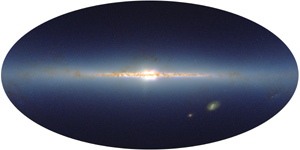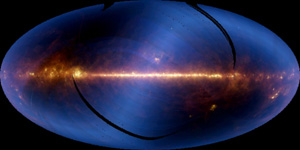|
 |


|

| An image of the entire
sky as seen in near infrared light centered on the Milky Way and
shown in aitoff projection. This image was compiled from the Two
Micron All-Sky Survey (2MASS). |
|
For thousands of years astronomers have been meticulously mapping the sky. Star charts of ancient Babylonian and Chinese astronomers, made by observing carefully with the naked eye and recording the information in stone tablets, survive to this day. The reason for mapping the sky is simple: to see what’s out there and where we are within it.
In modern times, astronomers use telescopes to survey the entire sky in multiple
wavelengths of light. These all-sky surveys are fundamental to astronomy, providing
the sources that define the normal Universe and giving the context to reveal
and understand the interesting abnormal objects. Sensitive all-sky surveys across
the electromagnetic spectrum are imminent or have recently been completed, but
a major gap remains in the mid-infrared. WISE will fill that gap, mapping
the entire sky in wavelengths of light from 3.5 – 23 microns during the first
6 months of the mission.
All-sky surveys at all wavelengths have been essential for the efficient use
of large telescopes and creating new fields of study. For example, the Palomar
Observatory Sky Survey (POSS) led to many different catalogs of celestial objects
found in the survey, such as the Abell Catalog of Galaxy Clusters. These catalogs
have provided the targets for detailed follow-up observations using big, narrow-field-of-view
telescopes such as the Keck Observatory, in Hawaii, or the Hubble Space Telescope.
Also, the all-sky survey done by NASA's IRAS mission spawned new fields of research
into objects such as ULIRGs and starburst galaxies.

|
An image of the entire
sky as seen in infrared light centered on the Milky Way and
shown in aitoff projection. This image was compiled from observations
of NASA's Infrared Astronomical Satellite (IRAS). |
|

|
All-sky surveys are also an efficient way to produce scientific results. A fast, shallow survey will find more astronomical sources than a targeted search. Plus, bright, nearby sources found in an all-sky survey are easier to follow up. This will be especially important for parallax and proper
motion studies of cool brown dwarfs to determine their spatial distribution. Additionally, a survey covering a large area provides a valuable database for later research. The POSS has define the visible sky for almost 50 years, and today Web-based servers handle thousands of requests for POSS data daily.
At the completion of WISE’s mission, the project will publish a catalogue of sources identified in the all-sky survey. This catalogue will serve as an essential source of targets to be investigated by NASA’s James Webb Space Telescope, planned for launch at the beginning of the next decade.
|
 |





